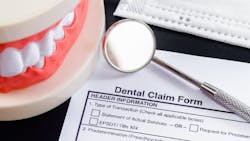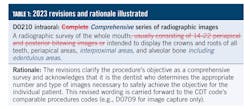2023 CDT code updates, and how to appeal a claim denial for SRP
Coding experts Kathy Forbes and Connie Simmons answer questions about the annual changes and new updates to the CDT codes. Update your office at the beginning of each year so you’re properly reimbursed.
Question: What has changed in the CDT codes for 2023?
Answer from Kathy Forbes: The Code Maintenance Committee (CMC) of the American Dental Association updated the CDT 2023 Procedure Code Manual to include 29 new additional codes as well as 14 revisions and two deletions. One of the more significant revisions relates to the comprehensive series of radiographs, shown in Table 1.
Previously the D0210 nomenclature stated this was an intraoral—complete series of radiographic images, usually consisting of 14 to 22 periapical and posterior bitewing images. The way the descriptor was written left room for interpretation, so the following illustration, from Guide to Intraoral Comprehensive Series of Radiographic Imaging Codes – Understanding the 2023 Revisions, is provided, along with the rationale as discussed during the CMC meeting.
This language also translates to three other CDT procedure codes:
D0372 intraoral tomosynthesis: Comprehensive series of radiographic images
D0709 intraoral: Comprehensive series of radiographic images, image capture only
D0387 intraoral tomosynthesis: Comprehensive series of radiographic images, image capture only
These changes were initially proposed by the National Association of Dental Plans (NADP) and the American Academy of Oral and Maxillofacial Radiology (AAOMR). There was much discussion during the CMC meeting regarding these revisions, with emphasis on including the imaging of edentulous areas in a full-mouth series (FMX), which was not previously proposed. With that addition, the revisions passed unanimously.
Read more coding articles:
New year, new ADA CDT codes
Coding for scaling and root planing
Question: How do you appeal a claim denial for D4341/D4342 (SRP) when the reason stated is “inadequate bone loss”? The patient exhibited 6 mm pockets in all quadrants with bone loss. How do we go about this?
Answer from Connie Simmons: Providing a complete and accurate diagnosis is the first step when submitting a dental insurance claim. Having 6 mm pockets does not describe the extent of bone loss, only the pocket depths. You must demonstrate the amount of clinical attachment loss. Does your periodontal charting show recession along with pocket depths in those areas? Are your radiographs of good quality (good paralleling technique) so they show the bone loss? Does your narrative include a diagnostic statement reflective of the 1999 AAP classifications of periodontal disease and the 2018 classifications, including staging and grading?
I work for eAssist and address appeals such as this, and I’ve found that many offices are still not using staging and grading to create a diagnosis for their perio patients. Use the format described below to determine radiographic bone loss (RBL). When I resubmit the radiographs with bone levels identified, as well as the measurements as defined below, I’ve had good success with claims being reviewed and reimbursed.
- Determine the stage using RBL. Use the ruler icon in your program software to measure the distance from the cementoenamel junction (CEJ) to the apex of the root at the site of greatest loss. (If you don’t know where the ruler icon is, ask your doctor. He/she uses it for endo.)
- Keep in mind a 2 mm distance on average from the CEJ to the alveolar bone crest is considered normal bone level height, so subtract 2 mm from the CEJ to apex measurement to determine where the bone levels should be in health.
- Next, measure the current bone level at the site (bone height to apex of the root). Subtract the current bone level from the healthy bone level number, and this will give you the bone level loss. Once you have the bone level loss number, divide it by the healthy bone level number and multiply by 100. This will give you a percentage of bone loss for staging severity when using RBL as a determinant (i.e., Stage I <15%, Stage II 15%–33%, Stage III and IV >33%).
Of course, all other important pieces of the periodontal assessment must be included: bleeding, suppuration, furcation involvement, minimal attached gingiva, etc. Documentation is key, including emphasis of any risk factors that provide evidence that this nonsurgical periodontal therapy (SRP) is a medically necessary treatment for the patient.
Editor's note: This article appeared in the March 2023 print edition of RDH magazine. Dental hygienists in North America are eligible for a complimentary print subscription. Sign up here.
About the Author

Kathy S. Forbes, BS, RDH, FADHA
Kathy has more than 40 years of experience as a clinician, educator, speaker, author, and consultant. Known for turning complex coding topics into clear, practical insights, she helps dental teams connect accurate documentation and coding with quality patient care. Kathy serves as chair of the ADHA’s new coding committee after serving as a director for the DentalCodeology Consortium for seven years reviewing and developing dental hygiene-related procedure codes. She presents testimony annually to the ADA’s code maintenance committee. Reach her at [email protected].

Connie Simmons, MA, BSDH, RDH
Connie Simmons, MA, BSDH, RDH, earned her BSDH from The Ohio State University and her MA in aging studies from Wichita State University. She’s worked in clinical hygiene for almost 37 years and has other roles in clinical training, sales, speaking, and writing. Her knowledge of dental insurance and coding grew while working with an insurance carrier, and she’s now part of the Dental Codeology Consortium and an associate productivity coach with Inspired Hygiene. She’s also an expert in the clinical use of silver diamine fluoride. Reach her at [email protected].

